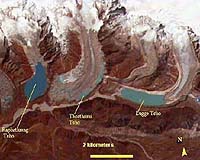 |
Kiel, Germany (SPX) Oct 06, 2010 Biodiversity decreases towards the poles almost everywhere in the world, except along the South American Pacific coast. Investigating fossil clams and snails Steffen Kiel and Sven Nielsen at the Christian-Albrechts-Universitat zu Kiel (CAU) could show that this unusual pattern originated at the end of the last ice age, 20.000 to 100.000 years ago. The retreating glaciers created a mosaic landscape of countless islands, bays and fiords in which new species developed rapidly - geologically speaking. The ancestors of the species survived the ice age in the warmer Chilean north. The exceptional biodiversity of the southern Chilean coast is known for a long time. More than 500 species of clams and snails are known from this area, twice as many as at comparable latitudes in the northern hemisphere. The reasons for this diversity were so far speculative, report Kiel and Nielsen in the current issue of the scientific journal Geology: "Opinions include that southern Chile is a museum of diversity where species survived for millions of years in addition to new arrivals; or that Antarctic species colonized this area from the south." Their analysis of around 35.000 fossil clams and snails, belonging to about 400 species, allowed the paleontologists to draw some more precise conclusions: "Our fossils reject both hypotheses. Biodiversity in this area always decreased toward the south in the geologic past, and we didn't find any intruders from Antarctica", explains Steffen Kiel. In addition, the researchers found that the vast majority of species and genera that lived in that area only 16 million years ago had become extinct. "This area is certainly not a museum of biodiversity", adds Kiel. The most species-rich groups of animals in the southern Chilean fiordlands are those inhabiting rocky shores. This is exactly the habitat that was created when the glacier retreated from their marine termini. "Molecular biologic investigations on phylogenetic relationships of these species show that they are geologically very young and descended from North Chilean ancestors. This agrees well with our results", says Sven Nielsen, who has been working on Chilean fossils for many years. "Charles Darwin, who was the first to discover fossils in this area during his voyage on the 'Beagle', would have been fascinated." This research shows that for species conservation not only single, exceptional habitats need to be protected, but that a diversity of habitats needs be conserved to maintain a healthy biodiversity.
Share This Article With Planet Earth
Related Links Kiel University Beyond the Ice Age
 Himalayan climate change action urged
Himalayan climate change action urgedKathmandu, Nepal (UPI) Oct 5, 2010 More regional and bilateral cooperation is needed to tackle climate change in the Himalayas, an Indian official said. "The behavior of Himalayan glaciers is fundamentally different from that of glaciers in the polar regions and they need special investigation and analysis," Indian Minister for Environment and Forests Shri Jairam Ramesh said Monday, The Himalayan Times reports. "B ... read more |
|
| The content herein, unless otherwise known to be public domain, are Copyright 1995-2010 - SpaceDaily. AFP and UPI Wire Stories are copyright Agence France-Presse and United Press International. ESA Portal Reports are copyright European Space Agency. All NASA sourced material is public domain. Additional copyrights may apply in whole or part to other bona fide parties. Advertising does not imply endorsement,agreement or approval of any opinions, statements or information provided by SpaceDaily on any Web page published or hosted by SpaceDaily. Privacy Statement |